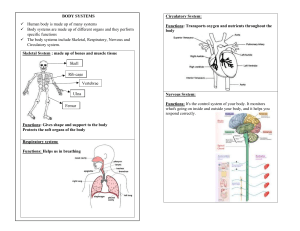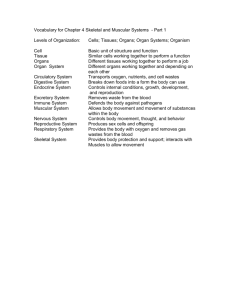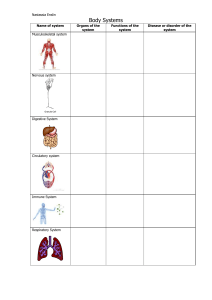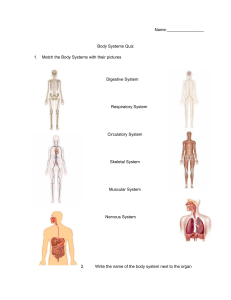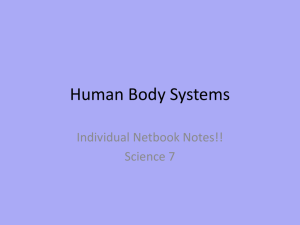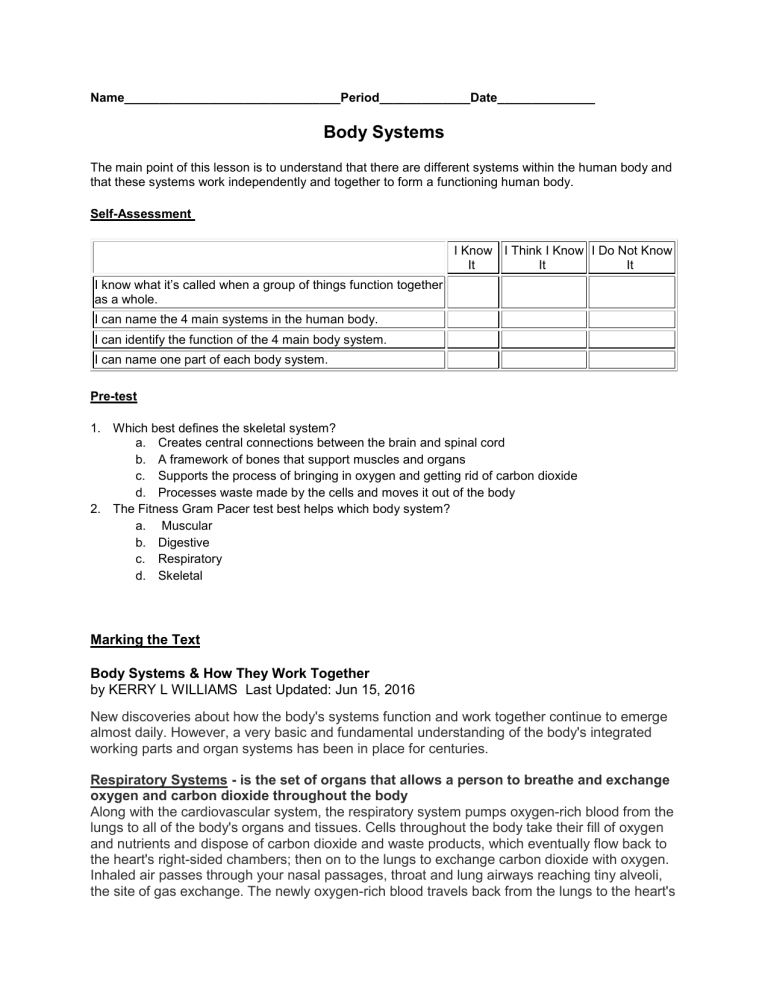
Name_______________________________Period_____________Date______________ Body Systems The main point of this lesson is to understand that there are different systems within the human body and that these systems work independently and together to form a functioning human body. Self-Assessment I Know I Think I Know I Do Not Know It It It I know what it’s called when a group of things function together as a whole. I can name the 4 main systems in the human body. I can identify the function of the 4 main body system. I can name one part of each body system. Pre-test 1. Which best defines the skeletal system? a. Creates central connections between the brain and spinal cord b. A framework of bones that support muscles and organs c. Supports the process of bringing in oxygen and getting rid of carbon dioxide d. Processes waste made by the cells and moves it out of the body 2. The Fitness Gram Pacer test best helps which body system? a. Muscular b. Digestive c. Respiratory d. Skeletal Marking the Text Body Systems & How They Work Together by KERRY L WILLIAMS Last Updated: Jun 15, 2016 New discoveries about how the body's systems function and work together continue to emerge almost daily. However, a very basic and fundamental understanding of the body's integrated working parts and organ systems has been in place for centuries. Respiratory Systems - is the set of organs that allows a person to breathe and exchange oxygen and carbon dioxide throughout the body Along with the cardiovascular system, the respiratory system pumps oxygen-rich blood from the lungs to all of the body's organs and tissues. Cells throughout the body take their fill of oxygen and nutrients and dispose of carbon dioxide and waste products, which eventually flow back to the heart's right-sided chambers; then on to the lungs to exchange carbon dioxide with oxygen. Inhaled air passes through your nasal passages, throat and lung airways reaching tiny alveoli, the site of gas exchange. The newly oxygen-rich blood travels back from the lungs to the heart's left-sided chambers, where it gets pumped out at great pressure via arteries to reach the needy tissues once again. Circulatory system – the organ system that circulates oxygen and nutrients through the body, consisting of the heart and blood vessels The newly oxygen-rich blood created by the respiratory system travels back from the lungs to the heart's left-sided chambers, where it gets pumped out at great pressure via arteries to reach the needy tissues once again. Skeletal System - The framework of the body, consisting of bones and other connective tissues, which protects and supports the body tissues and internal organs The skeletal system provides your body's shape, and it is made up of cartilage and bone. There are 206 bones in the human skeleton that provide a hard framework able to support the body and protect the organs that they surround. Cartilage provides support with flexibility and resistance, and acts as padding to soften the pressure that is exerted from the bones. Muscular System - is an organ system consisting of skeletal, smooth and cardiac muscles Movement in the body is the result of muscle contraction; when muscles combine with the action of joints and bones, obvious movements are performed, such as jumping and walking. The contraction of muscles provides the body posture, joint stability and heat production. Other body systems Digestive and Excretory Systems The digestive system is responsible for breaking down food into molecules small enough to be used by the body's cells and tissues. The food is broken apart through chewing and stomach churning, but also chemically -- through the stomach's acid-loving enzymes, and on to the small intestine, which receives pancreatic enzymes and juices specially tailored to dissolve and digest proteins, carbohydrates and fibers. Bile from the liver also works on fats. Though absorption of some drugs and alcohol may start in the stomach, absorption is mainly the function of the small intestines. Digestible nutrients pass through from the small intestines and their microvilli to capillaries and on to the liver for detoxification and further processing and conditioning, then out to the body. Fibers, indigestible material, bile and loads of bacteria travel through the large intestines and out through the colon and rectum. The kidneys filter out wastes from the blood to form urine, which flows down the ureters and enters the urinary bladder. The bladder collects the urine and releases when full, out through the urethra. Both digestive and excretory systems are regulated with input from the nervous system and endocrine system, and the cardiovascular system is inextricably linked with bowel and kidney function on multiple levels. Endocrine and Immune Systems The endocrine system uses hormones, or chemical messengers across distances to effect target organs and tissues. Hormones are typically produced by a gland such as the pituitary, thyroid or gonads, and released into the bloodstream. The pituitary is considered a master gland, since it governs the release of hormones by other glands. Unlike the nervous system, there is no physical "wiring" with neurons, however, and the hormones reach their target via the blood stream, where they exert their effect. The endocrine and nervous system may work together on the same organ, and each may influence the actions of the other system. The endocrine system largely governs many processes related to reproduction and sexual maturity, as well. The immune system is a network of cells, tissues and organs that work together to attack pathogens that try to invade your body. Bacteria, parasites and fungi that may cause infection meet a system of immune soldiers, including T-lymphocytes, macrophages and neutrophils. With time, the immune system's B-lymphocytes can produce antibodies against a new unknown invader. The immune system also plays a role in detecting non-self markers on cells that may arise in cancer cells and due to organ transplants. Stress, as perceived by the nervous system, can have a remarkable impact on the immune system and also the digestive system, which happens to be another major site of immune cell activity. Integumentary and Nervous Systems The integumentary system, or skin, is the body's first line of defense. It regulates body temperature, protects underlying layers of tissue from sun damage and prevents pathogens from freely entering your body. The integumentary system is also home to millions of nerves that respond to touch, pressure and pain. There are two interconnected nervous systems: the central nervous system and the peripheral nervous system. The central nervous system includes the spinal cord and the brain, which gets the information from the body and sends out instructions. The peripheral nervous system includes all of the nerves and sends messages from the brain to the rest of the body. The nervous system controls both voluntary and involuntary, automatic activities and bodily functions. Both the nervous system and endocrine system serve to integrate the body's various other systems, keeping things in synch. When the cardiovascular system is low on fluid, such as in severe dehydration, the skin loses its normal resiliency and can actually form a "tent" when pinched, instead of springing back into shape. Next let’s use the information we read to complete the questions: Match column A with column B. Write the letter of the correct match on the blank. Use CAPITAL letter. _____1. Digestive system A. removes extra water and waste materials from our body _____2. Skeletal system B. allows us to move different parts of our body _____ 3. Respiratory system C. provides the body with shape _____4. Circulatory system D. takes air into and removes air out of our body _____5. Nervous system E. breaks down food into substances our body can use _____6. Muscular system F. parts that help move substances to all parts of our body _____7. Excretory system G. the control center of our body Complete the chart with one body part that belongs to each system. muscular respiratory circulatory skeletal Indicate which organ system will be primarily used in the following situation. Write the beginning letter of correct organ system on the blank. M muscular S skeletal D digestive R respiratory N nervous E excretory C cardiovascular ______1. Prepare for a long swim by eating carbohydrates like pasta to give you more energy. ______2.You kick your legs as fast as you can to propel you through the water. ______3. You have to get out of the pool and use the bathroom because you drank too much water. ______4. You jump back in the pool and swim faster and notice your breathing rate is getting faster. ______5. As you swim the pool water feels warm on your skin. ______ 6. Swimming is a good exercise and strengthens your bones. ______7. The heart is pumping fast as you race to finish the last lap. CONGRATULATIONS!! YOU HAVE FINISHED SWIMMING AND USED ALL OF THESE BODY SYSTEMS TO DO IT!!! Post Test 1. Which best defines the skeletal system? e. Creates central connections between the brain and spinal cord f. A framework of bones that support muscles and organs g. Supports the process of bringing in oxygen and getting rid of carbon dioxide h. Processes waste made by the cells and moves it out of the body 2. The Fitness Gram Pacer test best helps which body system? e. Muscular f. Digestive g. Respiratory h. Skeletal Match the Body System to the correct definition. ____Respiratory A) is an organ system consisting of skeletal, smooth and cardiac muscles ____Circulatory B) The framework of the body, consisting of bones and other connective tissues, which protects and supports the body tissues and internal organs ____Muscular C) is the set of organs that allows a person to breathe and exchange oxygen and carbon dioxide throughout the body ____Skeletal D) the organ system that circulates oxygen and nutrients through the body, consisting of the heart and blood vessel
